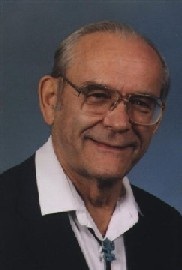
Ralph J. Slutz
1917 - 2005
Ralph J. Slutz Student Excellence Award in Computer Science, University of Colorado Foundation

Ralph J. Slutz Student Excellence Award in Computer Science, University of Colorado Foundation
Ralph J. Slutz, 88, a physicist and computer pioneer who made critical contributions in two milestones of the human computing history, passed away on November 16, 2005, at Boulder Community Hospital, Colorado, USA. Dr. Slutz was among the first four principal engineers working with John von Neumann to build a computer with a central memory to store and modify data and instructions (the well-known Electronic Computer Project, also called the IAS computer) at the Institute for Advanced Study (1946-1948), in Princeton, New Jersey. He later became the chief architect working with Samuel N. Alexander, Director of the Electronic Computer Laboratory of the National Bureau of Standards (the NIST now), to build the SEAC Computer, which was the first computer with an internally stored program in the US government, and the first operational machine of this kind in the US (1948-1950).
Ralph J. Slutz was born in Cleveland, Ohio on May 18, 1917. He received his Bachelor's Degree and Master's Degree in Electrical Engineering from the Massachusetts Institute of Technology (MIT) in 1938 and 1939 respectively.
Ralph Slutz was enrolled in the MIT 1938 class in 1934. He (the second from the right in the second row) and a group of MIT'38 classmates are in this picture. (Courtesy of the Slutz family). 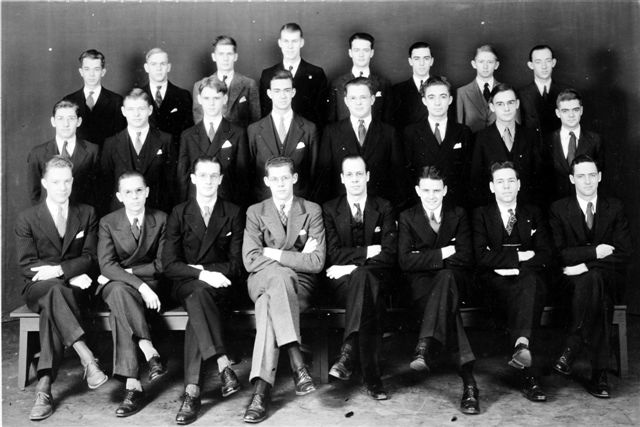
In the summer of 1938, the young Slutz made a brave cross-country bicycle trip with simple and light luggage. He started his journey from Cambridge, Massachusetts on the East Coast, and arrived in Oregon, West Coast, and then rode back to MIT on the East Coast. The bicycle trip originally started with three MIT students: Ralph, John Mitchell whose sister Margaret later married with Ralph, and William "Bosco" Burdett. Bosco only rode for a few days. John returned home after crossing part of Canada and reaching Michigan's upper peninsula. In this trip, Ralph endured tremendous hardships and overcame many difficulties. According to Ralph, this long and challenging bicycle journey really tempered his willpower so that he later became more determined and patient.
Ralph Slutz started his cross-country bicycle journey in the summer of 1938 from Cambridge, Massachusetts. This picture was taken during his trip in an unidentified location with an unidentified person (left in the picture). (Courtesy of the Slutz family). 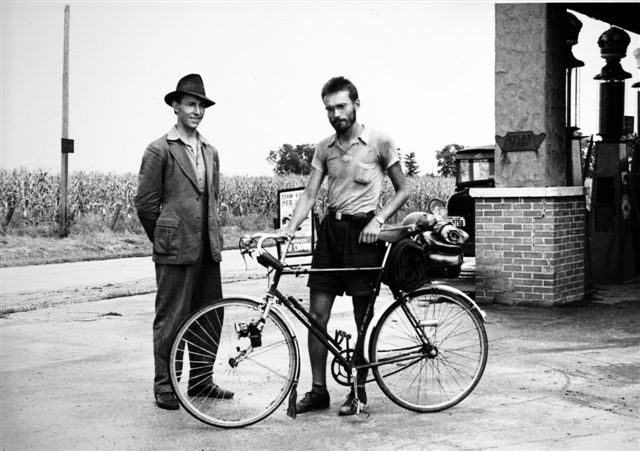
In 1939, Ralph left MIT for Princeton University to work towards his Ph.D. in Physics. During World War II, Ralph stopped his dissertation research to join national defense projects. He served in the Office of Scientific Research and Development, attached to the 8th Air Force, from 1943 to 1945. He received his Ph.D. in Theoretical Physics in 1946 from Princeton University. In the same year, he married Margaret Mary Mitchell (1919-2011) in June.
The completion of the ENIAC computer in 1945 represented an important milestone in human computing history. However, the original ENIAC machine only had computation capability, without a central memory to store programs and data. In June 1945, John von Neumann published a paper entitled ``First draft of a report to the EDVAC", where he outlined three basic components for a stored-program computer: (1) a memory containing both data and instructions; (2) a calculating unit capable of performing both arithmetic and logical operations on the data, and (3) a control unit to interpret instructions stored in memory and make necessary actions. This is the so called ``von Neumann model" that lays an important foundation for modern computer architecture design. von Neumann started the Electronic Computer Project to turn this model into a reality at the Institute for Advanced Study in late 1945. He first invited Herman H. Goldstine (1913-2004) who played a key role in the development of ENIAC, to join the project as the chief architect in 1946. One of the first four principal engineers von Neumann and Goldstine hired was Ralph Slutz who was a fresh Princeton University Ph.D. of 29 years old. The other three were Julian Bigelow (1913-2003), James H. Pomerene (1920-2008), and Willis H. Ware (1920-2013).Julian Bigelow in his article of "Computer Development at the Institute for Advanced Study" (a chapter in the book of A History of Computing in the Twentieth Century, 1980) had the following decription about the initial team of the von Neumann's computer project:
When I got to Princeton in June 1946, three engineers had already been employed without any knowledge or contact on my part, and two were on the way. In fact, they turned out to be excellent choices, and I should particularly like to mention James Pomerene, who is now an IBM Fellow, Ralph Slutz, who had recently finished his Ph.D. in Physics at Princeton and is now with the Bureau of Standards at Boulder, and Willis Ware, who is now with the Rand Corporation at Santa Monica.
Willis Ware in his 1953 RAND Report of "The History and Development of the Electronic Computer Project at the Institute for Advanced Study" , had the same acknowledgment to the initial team of the von Neumann's computer project:
At Princeton, Julian Bigelow, who was chief engineer of the original group, now holds a permanent appointment to the Institute and acts in a consulting capacity to the computer project; Jim Pomerene, one of the original staff, has remained at Princeton and is now in charge of the engineering. Willis Ware, another of the original staff, is now at RAND. Another original, Ralph Slutz, has been with the Bureau of Standards for several years, and had a large responsibility for the SEAC machine.
Ralph Slutz (Left in the picture) and James Pomerene (1920-2008) (right in the picture) were in a conversation during a tea time in the Institute for Advanced Study in 1946. (Courtesy of the Slutz family). 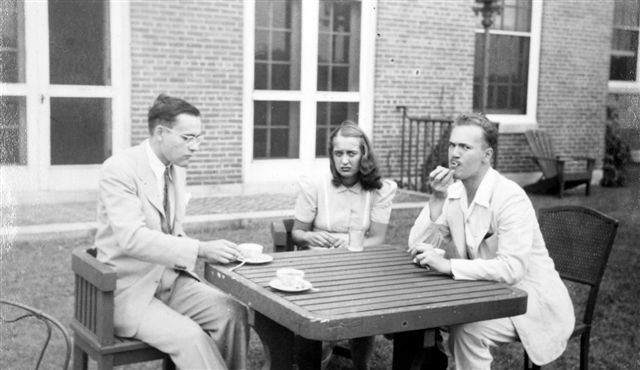
Ralph had two productive years working in the IAS Computer project from 1946 to 1948. He was actively involved in several innovations of advanced computer architecture technologies of CPU and memory storage. He and Rrichard Snyder (1911-1996) also had an invention on "Static Megnetic Memories". In the letter to Dr. Robert Oppenheimer who was the IAS Director then, Richard Snyder and Ralph suggested that their invention be open to the public. In the reply letter , Dr. Oppenheimer stated that he and Professor Von Neumann had agreed "that in as much as all the work that was done on the computer was placed in the public domain". This may be a starting point of the "open source" concept in the early stage of the computing field. Here is a paper co-authored by the four principal engineers, Bigelow, Pomerene, Slutz, and Ware, entitled ``On the physical realization of an electronic computing instrument", where detailed hardware implementations of this stored-program machine were presented. (only the cover-page is linked here).
This picture of Ralph Slutz was taken in his office at the Institute for Advanced Study in 1947. (Courtesy of the Slutz family). 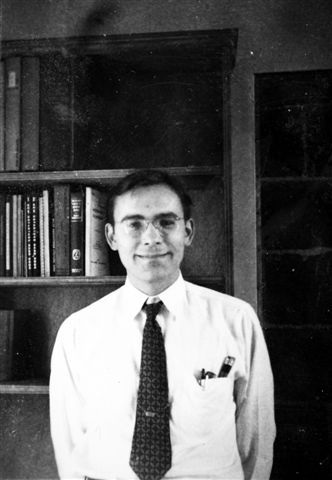
This picture was taken by Willis Ware during Christmas, 1947. According to Willis Ware, a group of IAS Computer Project people sang Christmas carols in front of the house of Albert Einstein (1879-1955) on Christmas eve. Einstein and his housekeeper came to the front door to recognize and greet these young singers. From left: an Army meteorologist, Ralph Slutz, a young high school intern in the IAS Computer project, James Pomerene (1920-2008), Floy Ware (Willis Ware's wife), Edie Pomerene (James Pomerene's wife), Ted Hildebrandti, and Lt. Philip D. Thompsoni (another Army meteorologist). (Courtesy of the Slutz family). 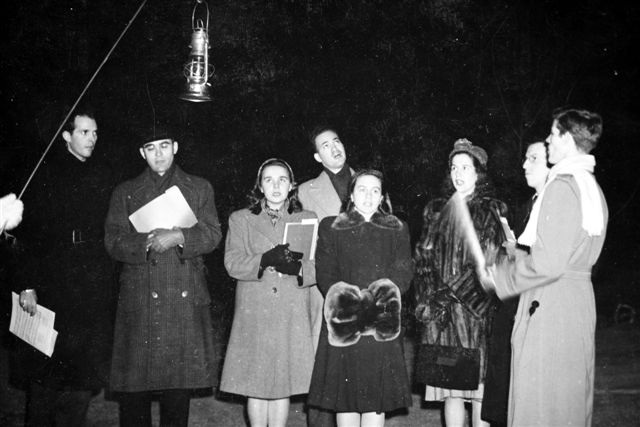
The reason why Ralph left the Institute for Advanced Study's Computer Project after only two years besides the opportunity to build SEAC in NBS was little known. He seemed to avoid mentioning about it during his lifetime. According to the Computer Oral History Collection archived by Lemelson Center for the Study of Invention and Innovation in the Smithsonian National Museum of American History, Ralph had different technical opinions from Von Neumann and Jilian Bigelow on the selection of memory models. Morris Rubinoff (1917-2003), another computer pioneer, made the following comments in his recollections of the Institute for Advanced Study history:
At that time Ralph Slutz was arguing that in spite of the fact that Von Neumann thought it ought to be implemented on an asynchronous parallel basis that's not the way technology will allow systems to be built. And Ralph Slutz and Julian Bigelow debated this question.
Von Neumann and Bigelow proposed to use the Selectron Tube that was an early form of digital computer memory developed by Jan A. Rajchman and his group at the Radio Corporation of America (RCA). Jan Rajchman indicated that he could make an asynchronous parallel type memory via Slectron. The development of Selectron Tube for the Computer Project started in 1946 under the order of Von Neumann with a planned production by the end of the year. However, the Selectron Tube based on asynchronous parallel memory could not be produced after two years. By that time, the Computer Project in the Institute for Advanced Study was forced to switch to the Williams tube for storage that was developed in 1947. RCA eventually gave up the concept of asynchronous parallel type memory.
This early part of the history in the Computer Project witnessed that Ralph's argument was right. His SEAC machine successfully adopted the Williams tube before the Institute for Advanced Study machine did. He objectively argued and challenged the decision made by the top authority with his technical basis, which reflected his meticulous scholarships started from his early career. Morris Robinoff gave the following comments on Ralph's leaving from the Institute for Advanced Study to NBS:
The early history is that Ralph Slutz did go to the National Bureau of Standards and designed and built SEAC which was done in something like 18 months and running at that time. It was vacuum tubes with transformer coupling and diod switching and megnetic wire input-output. Those are key items.
In 1948, Ralph left the Institute for Advanced Study, and became the chief architect with Samuel N. Alexander (1909-1967) to build the SEAC computer for the National Bureau of Standards (Standards Eastern Automatic Computer) in Washington DC. The SEAC machine, completed in 1950, was the first computer in the US government with an internally stored program, and the first operational computer of this kind in the US. Besides new techniques in memory systems, SEAC also originally introduced several innovations that were later adopted in modern computers: (1) I/O mechanisms for data processing, (2) time-sharing (running multiple programs in the computer concurrently), (3) the interconnection of two computers in 1954 for data communication, and (4) a graphical display. Ralph's paper entitled ``Memories of Bureau of Standards SEAC" has become an important part of the historical record of human computing. Ralph received a Silver Medal for the Exceptional Service in the Design of the SEAC Computer by the US Department of Commerce in 1951. In his paper of ``Memories of the Bureau of Standards' SEAC", published in the book A History of Computing in the Twentieth Century in 1980, Ralph Slutz wrote, ``At this point I should like particularly to remember Sam Alexander, who was the moving spirit in the Bureau's hardware work on computers, and who should be writing this paper if he were still alive. he always treated me more like a son than an employee, and we had a warm and productive relationship."
In this picture, Ralph Slutz (sitting in the left) was examining the SEAC's paper tape punched with input data; and Samuel Alexander (standing on the right) was examining the computer's printout. This picture was taken in 1951 (courtesy of NIST). 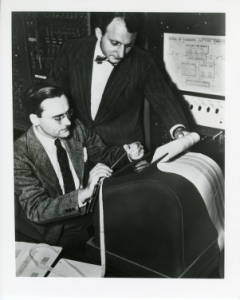
NIST archives the Oral history interview of Ralph Slutz in June 1976, in which Ralph talked about his experiences of building the two early computers in late 1940s and early 1950s.
In 1954, Ralph Slutz was appointed as Chief of the Radio Propagation Physics Division, leading research and development of time and frequency using radio broadcasts, in the newly established NBS Boulder Laboratories (note: his Lab is called the Central Radio Propagation Laboratory). He left Washington DC in 1954, and had lived in Boulder, Colorado, since then until he passed away in November 2005. He played an important leadership role in research of time and frequency that pioneered atomic clocks, and disseminated time and frequency by radio broadcast. Ralph served in the Science Advisory Committee for both President Harry Truman and President Dwight Eisenhower in 1950's. During this period, Ralph mainly focused on his research in the area of radio electronics with his strong physics background. As a guest physicist, he also spent a year conducting research in the Max-Planck Institute in Munich, Germany, in the academic year of 1960 to 1961.
As soon as Ralph came to Boulder in 1954, he was named as professor adjunct, and taught a class called "Computer Solutions to Engineering Problems" at the Electrical Engineering Department in the University of Colorado at Boulder. This was probably the first computer related class offered in University of Colorado when there were only several highly expensive and giant computers available in the world.
In September 1954, President Dwight Eisenhower led a distinguished delegation to dedicate the NBS (now NIST) Boulder Laboratories. In this picture, Ralph Slutz was giving a presentation to President Eisenhower. Allen Astin, the NBS Director then (on the right side of the President) was also at the presentation. (Courtesy of the Slutz family). 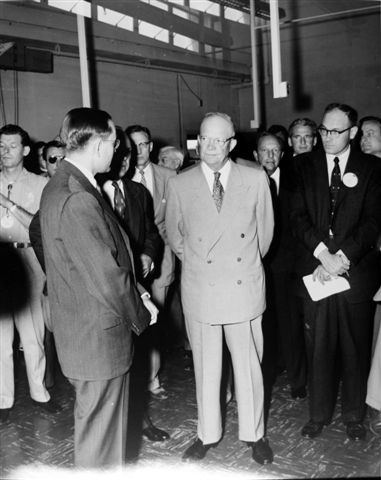
In 1980, after his 32 years of distinguished career as a scientist and leader in the National Bureau of Standards, Ralph retired from his government position. He then joined Cooperative Institute for Research in Environmental Sciences (CIRES) in the University of Colorado at Boulder, as a senior scientist. He also remained his professor adjunct appointment in the Electrical Engineering Department at CU Boulder. He became a major architect and leader of a well-known and visionary project to create a Comprehensive Ocean Atmosphere Data Set (COADS) that would be shared by scientists all over the world. This huge scientific database has had a significant and continuous impact in helping scientists better understand and predict our ocean and atmosphere behavior by studying the historical data collected all over the world since 1854. Ralph was a lead author of the original paper of COADS, entitled "A comprehensive ocean-atmosphere data set", published in Bulletin of American Meteorological Society in 1987. (Note: the COADS project was originally launched by Joe Fletcher (1920-2008), who was a well respected climate scientist and a distinguised leader. He led an US Air Force exploring aircraft (C-47) to land on the North Pole in 1952, which was the first time in human history).Between 1983 to 1985, Ralph hired Xiaodong Zhang as his research assistant in the COADS project. Xiaodong was a fresh college graduate from China then, and was a graduate student of Computer Science in the University of Colorado at Boulder. Xiaodong spent two ``privileged" years closely working with a world-class scholar, which had a huge impact on his later life and his career in the US. Xiaodong was Ralph's only formal student under his supervision in his life. The mentorship and friendship between Ralph and Xiaodong had lasted more than 20 years. Directed by Ralph, Xiaodong completed his Master thesis on An approach to a portable data compression system in the Spring of 1985. The data compression techniques proposed in this thesis have been used in the COADS database.
Invited by the Chinese Academy of Sciences, in 1985 summer, Ralph and his assistant Xiaodong took a three month trip to China to distribute an early version of COADS database, and to give a series of lectures on its numerical methods and the software system. Xiaodong was also Ralph's translator for all of his lectures at the Chinese Academy of Sciences, China National Ocean Administration, and several other universities. Both of them did much hands-on system work to help Chinese colleagues access the database and use the software for scientific research.
On the way to China in 1985 summer, Ralph and Xiaodong paid a visit in the Pearl Harbor in Honolulu, Hawaii. 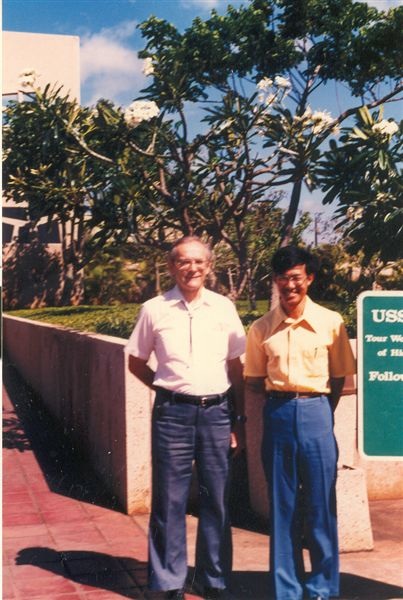
Acknowledgment
With the highest respect to Ralph Slutz, I made this Web page as a memorial to him. I am grateful to Margaret Slutz (1919-2011), Ralph's wife, for her care and help when I first came to US, and for her many years' friendship. I appreciate Karen, Rob, Eric, and Don, (Ralph's four children) for providing me with the historical documents about Ralph. Eric Slutz provided high quality technical support for these pictures. I would like to thank Dr. Willis Ware, Ralph's colleague on the Instutute for Advanced Study's Computer Project, who is another computer pioneer, for his advice and many e-mail communications. Finally, I would like to acknowledge George Dyson whom I first met in the USENIX ATC 2005 conference after his keynote speech. George is a historian of computer pioneers and grew up in Princeton University. He has given me valuable suggestions and his encouragement.
My memory systems research has been inspired by Ralph's pioneer work on stored-program machines in building the Institute for Advanced Study Computer and the SEAC Computer at NBS; and I took a new position in Ralph's home State of Ohio after his departure in 2006. This must be fate.
Xiaodong Zhang
December, 2005
in Columbus, Ohio, USA.